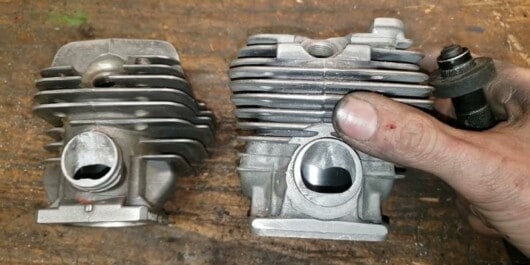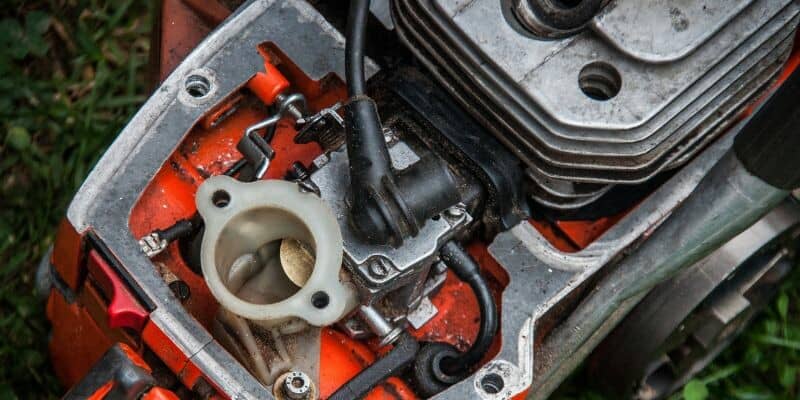Are you a chainsaw user looking to port your chainsaw, but don’t know the right way to do so? If so, then you are definitely in the right place at the right time.
Porting a chainsaw involves opening the exhaust and making it larger, freeing up more space, and tweaking the transfer ports. There are other methods that you can follow as well including, trimming off the jug for a bit, grinding the port tightly so that the engine breathes more, enabling the muffler to be wider to its original design, turning the carburetor to become richer, and more.
In this article, you will get to know all about porting your chainsaw, what do you mean by chainsaw porting, how to port chainsaw, cautionary measures to follow when porting a chainsaw, the benefits of porting, and more. Continue reading to get all the answers that you are looking for.
What do you mean by chainsaw porting?
There are a number of ways you can modify your chainsaw, and chainsaw porting is just one of them. You will be making a few alterations like changing the shape of the cylinder, fine-tuning the port’s timing, and replacing the carburetor. There are multiple reasons why chainsaw porting is done. For instance, the compressor ratio can be increased, which results in more power and better performance. It will affect the torque, power curves, and response time in the chainsaw. Additionally, the operating temperature will become cooler, which results in lesser wear and tear while also increasing its lifespan.
How to port chainsaw
There are a number of ways you can wood port a chainsaw, and it’ll depend on what you’re going to do with the modified version of the chainsaw. In some methods, you might not be even with a lot of space for exhausting the air. So, you should ensure that your chainsaw can breathe better with the muffler. Moreover, try to make sure that the temperature of your chainsaw remains low. Here are the step-by-step instructions on how to port chainsaw.
Step 1: Open up and make your exhaust larger
The exhaust passageway is the entrance path to the internal portion of your chainsaw. The muffler has to be opened carefully. There are many methods of doing so, which can be done by grinding, drilling, or using other tools at your disposal.
You need to check on the intake and the exhaust port. You should make the ports larger by using various tools. Once the muffler has got a big enough gap, make sure that the exhaust path is roomy enough such that it can fit your hand.
Step 2: Free up some more space
Once you’ve gained wide admission to the inner portion of the chainsaw, you should create some more space in the exhaust system and intake. There are many ways to do so using various tools. You can also do squishing, which will make the chainsaw jug lower. You will be making use of a thin gasket, and this procedure is known as milling.
Step 3: Tweak the transfer ports
Once you’ve finished the previous step, the compressor ratio of your chainsaw will be significantly improved as it was before. If you wish to alter it some more, there are a few other things that you can try –
- The compressor transfer ports can be modified further
- Take out any excess material for the piston for enabling it to be lighter
- Alter the mechanical timing of the port by grinding and polishing
- Take out the RPM limiter coil or replace the coil with a non-limited kind
- Polish the piston ports
After performing these steps, the engine of the chainsaw will become significantly powerful from the extra charge in the compression ratio.
Step 4: Sawdust usage
The first three steps mentioned above are standard procedures and are safe to do so. However, there are a few other methods of chainsaw porting that have the same effect of power increase.
One way that is considered to be an irregular method would be by utilizing sawdust. Take a bit of sawdust and fill the chainsaw’s combustion chamber to the brim. The effect will be the same in supercharging the combustion ratio, enabling the engine to be powerful at sawing. Your saw will now operate to its maximum capacity while having an inordinately high ratio of compression.
However, there is one disadvantage to this procedure, where the heat will not lessen. This is the reason that most chainsaw owners and users prefer to enable portion instead of doing this, while also destroying the chamber if done continuously.
If you are looking to learn how to port a Stihl chainsaw, the above methods will not work. For Stihl chainsaw models, you can do these methods for increasing the power – modify the muffler, enlarge the ports, and tune the carburetor again.
Cautionary measures to keep in mind
The ports will serve a key function in a typical chainsaw and must be treated with care and deference. There are many YouTube videos dedicated to different porting procedures. Moreover, you could even consult a local repairman for that.
Some people do not actually practice caution when attempting to increase compression. They enable the exhaust ports to be too broad such that the rings may get clipped. Improperly porting the chainsaw engine could severely cut down on power and, in certain situations, even result in destruction. As a consequence, it’ll feature weaker power and sawing wood will be more difficult and arduous.
If you’re porting the chainsaw, remember that it might void its warranty. If you end up making a mistake and doing something incorrectly, resolving the issue will cost a lot. Moreover, the fabricator you might have hired for porting your chainsaw might not offer a guarantee that they’ll be successful. Some fabricators make use of strange methods that might or might not work for your chainsaw.
Lastly, even if it is an excellently ported chainsaw, you will not get a decent price for it if you are going to sell it. In most situations, a fabricated chainsaw will not have any added value in the market.
Benefits of porting a chainsaw
Aside from increasing the power, porting can greatly lower the muffler’s backpressure. If you retune the carburetor alongside porting it, your chainsaw can enjoy many benefits like –
- It runs better and is more reliable and efficient
- It’ll have a lower temperature and run cooler and wouldn’t get worn out easily
- It’ll allow for more breathing room for the moving components of the chainsaw
Many chainsaw users incorrectly surmise that porting the chainsaw can make the chainsaw less reliable. It might happen if you’re doing it incorrectly. However, if you do things properly, it’ll improve its lifespan and reliability. Hence, it is a positive impact on the chainsaw itself.
Porting a chainsaw yourself vs. hiring a professional
Regardless of how reputed or talented the professional is, one thing that can be guaranteed is inconsistency. You must choose the builder with much care and after ample research. Remember to keep in mind that the gains from the ported chainsaws will differ based on the experience and expertise of the builder.
You shouldn’t be fooled by the hype of the professional. Hype will not make a builder good at porting the chainsaw. In most cases, the turnaround time will be horrible. There are many types of builders, such as local builders and the ones you find in online communities. The average turnaround time will be 6-8 weeks, while sometimes it might take months.
Most people prefer going to a mechanic to “upgrade” the stock chainsaw to a newer version without knowing a lot. Porting the chainsaw is costly and could take up to $500. It isn’t a small amount, even worse, you might not get what you’re paying for if you don’t find the right mechanic.
If you haven’t got any reliable professional in your area, you should search online and look for a remote mechanic. Sipping back and forth doesn’t come cheap and may force you to spend some more money. Due to taxes and customs duties, you might not be interested in using UPS. Compared to the lifelong use of your chainsaw, a few dollars extra on shipping isn’t a big deal.
The basics of porting chainsaw yourself
Porting a chainsaw is an important practice. Similar to splitting wood or cutting with a chainsaw, porting the saw will also require a lot of expertise and knowledge to do it successfully. If you aren’t familiar with modifying chainsaw engines, you need to stay away from porting the chainsaw until you learn more.

Needless to say, you need to have proper knowledge of how a chainsaw engine works. You will also require practical experience modifying minor things before you proceed to a major modification. Once you’ve acquired ample knowledge and experience, you will require a plan of action for doing things properly. It would be helpful if you’ve got a skilled professional to supervise you. Otherwise, there is a chance you might damage your chainsaw permanently. In certain situations, it might not be repairable.
FAQs
How to carry a chainsaw in the woods?
You must carry the chainsaw with the chainsaw bar pointed behind you. If it is pointed forward, even when it is off, you might trip and fall on it. Make sure that the muffler is located away from your body as you are walking. Moreover, engage the chain break any time you’re taking a step with a running chainsaw.
What is the best way of hanging a chainsaw?
Proper care must be taken while you’re hanging the chainsaw. It must be hung upside down so that it is on the safe side. You must hang the chainsaw vertically where there isn’t any exposure to dust, dirt, rusting, or other damaging factors.
What do you mean by chainsaw kickback?
Chainsaw kickback is the term used for describing the unexpected upward motion of the chainsaw’s guide bar. Kickback usually occurs when the end portion of the nose of the bar strikes any object and the chain snags momentarily or is pinched.
Should you be running a chainsaw at full throttle?
Generally, two-stroke chainsaw engines come to run at full throttle conveniently without an engine breakdown. Therefore, running the chainsaw at any throttle speed below the full throttle isn’t usually advised.


